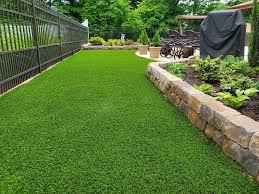Pet turf, also known as artificial grass is becoming more popular among pet owners seeking a durable and low-maintenance alternative to conventional lawns. The turf is specifically designed to withstand damage and wear of active pets, pet turf offers several benefits and features that make it an attractive alternative. Learn what you need to learn about pet turf to decide if it’s right for your home and furry friends.
Durability and Maintenance
One of the biggest advantages for synthetic turf is its durability. Unlike natural grass, which can become uneven and worn-out from heavy foot traffic, pet turf is designed to withstand constant usage. It’s made from synthetic materials that resist tearing, fading and matting, which means you’ll have a long-lasting area for your pet to play on.
Maintenance is another aspect where pet turf excels. Lawns of the traditional type have to be maintained regularly, mowing, and watering, which is time-consuming and costly. The pet turf requires minimal upkeep. It doesn’t have to be cut, and it doesn’t require watering, which saves time and cost. It is recommended to brush it regularly in order to keep its grass upright and occasional rinsing to remove debris and odors are generally enough for keeping pet turf looking fresh and clean.
Hygiene and Safety
Pet turf is designed with the idea of hygiene in mind. There are many varieties of pet turf have built-in drainage systems that allow liquids to move through with ease, preventing puddles and minimizing the risk of odor buildup. This is particularly helpful for pet owners as it assists in keeping the area tidy and clean. Additionally, pet turf is often made with antimicrobial materials that help reduce the development of fungi and bacteria which further improves the hygiene.
Safety is a further factor to consider. The turf for pets is constructed with non-toxic materials that are free of hazardous chemicals that can be present in some organic grasses as well as pesticides. It is also designed to offer adequate traction, which reduces the possibility of slips and falls occurring for your pet.
Environmental Impact
While pet turf does offer numerous benefits, it’s important to consider its environmental impact. Synthetic turf is fabricated from plastic materials, which aren’t biodegradable and could contribute to the waste of landfills. However, many manufacturers are working on green alternatives like turf made of recycled materials and those made to be completely recyclable.
Cost Considerations
The initial expense of installing pet turf can be higher than maintaining a natural lawn. However, the benefits over time on fertilizers, water and lawn maintenance services could offset the initial investment. Additionally, the durability and low maintenance requirements often result in an extended life span, which makes pet turf a cost-effective solution in the long run.
Conclusion
Pet turf provides an effective and appealing solution for pet owners seeking an affordable, durable, and hygienic surface for their furry friends. Although there are environmental aspects to be mindful of, the benefits often outweigh the disadvantages for many pet owners. If installed correctly and properly, pet turf can provide an enjoyable and secure outdoor space for your pet to play and take a break.


